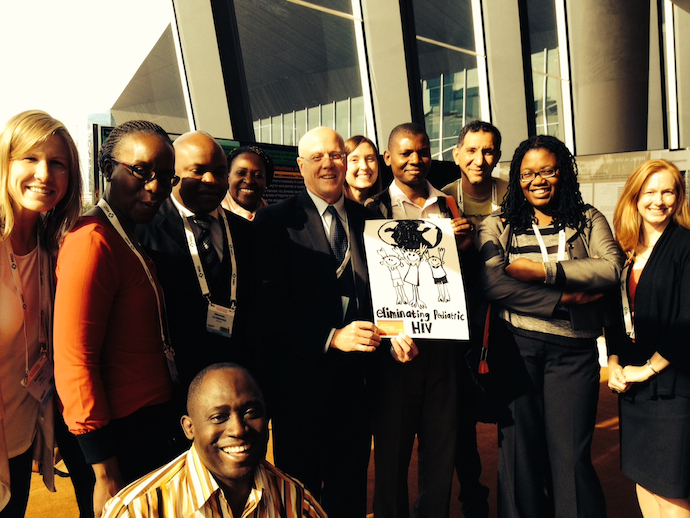Because the fight against HIV/AIDS is a global one, decisions about how to tackle the epidemic take place in many forums with differing perspectives. Whether it is happening at the African Union Summit or at the 20th International AIDS Conference (AIDS 2014) the Elizabeth Glaser Pediatric AIDS Foundation (EGPAF) is a strong presence and a vocal champion for the health of children, families, and communities affected by the HIV/AIDS epidemic.
At AIDS 2014, held last month in Melbourne, Australia, EGPAF participated in several pre-conference meetings, satellite sessions, and exhibit several abstract-driven poster presentations. Here are a few my top takeaways from #AIDS2014:
Start Early, Start Now, Step Up the Pace
Children continue to seriously lag behind adults with access to treatment. In fact, only 24% of children living with HIV are on antiretroviral therapy (ART), especially alarming considering half will die by their second birthday without treatment. Thankfully, the unique needs of children with HIV are finally getting some much-deserved space in global HIV/AIDS conversations. From the two-day symposium Children & HIV: Start Early Start Now to Bill Clinton’s electrifying plenary speech, children living with HIV and the critical need to prioritize kid-friendly HIV treatment, care and support was a big part of the IAS conversation. And it wasn’t just talk. There was plenty of action and the proverbial putting of money where one’s mouth is. Medicines Patent Pool (MPP) announced an extended agreement with Gilead Sciences, Inc. around a promising new HIV medication that down the road could be a new first-line treatment option for children, and USAID-PEPFAR announced an investment of more than $500 million to accelerate progress toward an AIDS-free generation.
Stigma: A deadly Foe in the Fight to end AIDS
EGPAF is focused on ending AIDS in children and families through research, advocacy, and integrated HIV-service delivery to the people in greatest need in the areas with the highest HIV burden. We also work to overcome social drivers that can be barriers to HIV testing, treatment, and care. But as evidenced by the testimony of many AIDS 2014 attendees from all walks of life, the pervasive threat of stigma remains a life-threatening barrier to the global AIDS plan.
As Caroline Zinyemba, communications and advocacy manager for EGPAF Zimbabwe noted, "despite the progress with the science, stigma & discrimination is on the rise–innovation in documentation of this old/new face of HIV fight is vital." Until no child has AIDS, we must make every effort to ensure that fear of HIV/AIDS stigma never keeps a man, woman, or child from getting the information, treatment, and care they need.
This message was reinforced this week in Washington, DC as well. “People die from stigma,” said former President, George W. Bush, at the 2014 U.S.-Africa Leaders Summit “While stigma may seem like a high, unbreachable wall, you’ve got to realize it’s made of glass. It can be broken.”
Toward an HIV Cure
There is increased enthusiasm within the global HIV/AIDS community and promising scientific endeavors around finding a cure for HIV, a disease that has impacted millions of individuals around the world over the last 30 years. President Obama’s announcement, last December, of $100 million of AIDS research funding to be redirected “to expand support for research directed toward a cure for HIV” helped to shift the focus of HIV research in the direction of the cure agenda.
Numerous presenters in Melbourne reflected on how the virus works in a person’s body and how much more we need to understand about the virus before a cure or vaccine can become a reality. The ability to cure an HIV infected baby of the virus would revolutionize the HIV response and help us to achieve our goal AIDS-free generation. While the recent news that doctors had discovered detectable levels of the HIV virus in the Mississippi Baby, previously thought to have been “functionally cured,” is disappointing for the HIV/AIDS community, the knowledge gained by studying the Mississippi underscores the value of a robust HIV agenda and the need for increased investment in HIV cure research.
The Final Chapter of the AIDS Epidemic?
UNAIDS ambitious new treatment targets, call for 90% of all people living with HIV to know their status, 90% of all people living with HIV infection to receive sustained ART, and 90% of all people receiving ART will have durable viral suppression by 2020. These “90-90-90” targets also include children living with HIV.
EGPAF President and CEO, Chip Lyons, discussed EGPAF’s leading role in developing these targets for pediatric patients and what we need to do to achieve them during a UNAIDS satellite session. Chip also joined the International AIDS Society (IAS) and ViiV Healthcare for a press conference announcing an additional £1.5 million in funding for its pediatric HIV program, the Collaborative Initiative for Pediatric HIV Education and Research (CIPHER).
My colleagues and I left the land down under with plenty to think about, to celebrate – and yes – plenty to find solutions to. I also left reenergized and inspired by these new ambitious goals and the unwavering global commitment to ending the AIDS pandemic as part of the push towards the Millennium Development Goals deadline, just 500 or so days away, and beyond. We’re making undeniable progress, but there’s still work to do.
Elizabeth Glaser’s promise to her children is EGPAF’s promise to the world’s children and we’ll do whatever it takes until no child has AIDS.
On August 7, the Kaiser Family Foundation and the Center for Strategic and International Studies (CSIS) held a briefing to assess the major outcomes of the AIDS 2014 The panel comprised Chris Beyrer, President of the International AIDS Society; Ambassador Deborah L. Birx, the U.S. Global AIDS Coordinator; and Stephen Morrison, Senior Vice President and Director, Global Health Policy Center at CSIS. Jen Kates, Kaiser Family Foundation Vice President and Director of Global Health and HIV Policy, moderated the panel discussion. Watch the full event.




